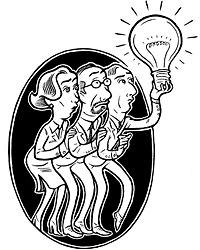GE’s Next Workout
The industrial giant’s legendary learning center, Crotonville, has a new assignment: Teach every manager to be a strategist.
 |
|
Illustration by Lars Leetaru |
GE CEO Ralph Cordiner (with the help of Peter Drucker) established a new wave of scientific management after World War II, in which every detail of management work, down to the placement of pens on desks, was spelled out in elaborate “blue books.” Then in the 1980s, GE CEO Jack Welch launched Work-Out, the company’s infamous bureaucracy-busting productivity initiative, an attack on
scientific management demanding that executives shun rote rules and become candid, fast on their feet, and flexible. Despite their differences, Mr. Cordiner and Mr. Welch held the same core idea about organizational change: The only way to shift a company’s culture is to change the habitual thinking and behavior of its fast-track executives.
Right now, GE is making another full-scale effort (unhidden but also unflaunted) to change the way executives think and behave. Under Jeffrey Immelt, who became chief executive two years ago, executives at Crotonville are studying future technology, corporate social responsibility, system dynamics, and long-range planning. The purpose is to systematically build the capabilities of managers throughout the company — capabilities that enhance strategic thinking and cut down on bureaucratic decision making.
In other words, GE wants smart managers at many levels to be able to make the kind of strategic judgments and bets on bold new projects that would have been made by only the most senior executives in the past.
“All the way through the 1980s and 1990s, Welch focused on taking the fat out of the system, on making tough decisions, on productivity, and on bottom-line growth,” says Bob Corcoran, the current director of Crotonville (and a long-standing HR manager before that at GE Medical Systems, the business that Mr. Immelt ran before becoming CEO). “Jeff inherited a company skilled at execution — one that can stop on a dime and deliver results. The company just loves to execute. Now the question is how to develop the top line.”
Mr. Corcoran doesn’t mean “top line” in the ordinary managerial sense of increased revenue. He means new products, markets, and lines of business, particularly ones that require long-term investment and technological innovation, where few can match GE’s capabilities. To accomplish that shift, GE is drawing on its own extensive history with management innovation, particularly with Work-Out, which began 15 years ago as a vehicle for improving productivity and developed into a widely felt mechanism for cultural change. If this ambitious initiative works, GE’s current leaders could return the company to its roots, as a major force in the creation of new technological infrastructures like the electric power grid and the radio broadcast systems it pioneered. And if history is any guide, wherever GE takes management education, much of the rest of corporate America is likely to follow.
No Consolation Prize
People inside and outside GE consider the Work-Out program to be perhaps the single most vital part of the Welch “revolution” — the component that made Mr. Welch’s ideas comprehensible and palatable to people throughout the company. Many of the external consultants who helped design and deliver Work-Out — including such well-known academics as Noel Tichy and David Ulrich at the University of Michigan and Harvard’s Todd Jick, as well as management authors such as Steven Kerr, currently the chief learning officer at the Goldman Sachs Group Inc. — have essentially based their consulting practice on Work-Out. The GE Work-Out: How to Implement GE’s Revolutionary Method for Busting Bureaucracy and Attacking Organizational Problems —Fast! (McGraw-Hill, 2002), by Dr. Ulrich, Mr. Kerr, and consultant Ron Ashkenas, is only one of several guides in print. The corporate change cognoscenti whom I know agree with Jim Baughman, the Work-Out architect who was a Harvard Business School professor before becoming the first head of Crotonville under Mr. Welch: “It’s the most successful program I saw in 40 years of practice.”
The late 1980s and early 1990s were renaissance years for process improvement, and Work-Out borrowed liberally from these ideas. Sociotechnical systems, quality management (as taught by W. Edwards Deming, Joseph Juran, and Philip Crosby), lean manufacturing, process mapping, the “wisdom of teams,” Motorola’s Six Sigma approach, and even reengineering, despite their differences and rival factions, were all in full flower. And they all had the same concept at heart: If you give people local autonomy and a reason to focus on improving quality, you can supercharge productivity on a global scale. With Work-Out, GE took that principle and rolled it out across a dozen separate large businesses; it was impressive how quickly and effectively Work-Out permeated the management culture.
The Work-Out initiative began as a natural outgrowth of GE’s newly revitalized conference center at Crotonville. After years of relative neglect, Mr. Welch invested billions of dollars in remodeling both the facilities and the curriculum, and much of his own time talking up its significance. His intent was to send a signal to the entire work force that management learning was now not just a frill, but a coveted prerequisite and central corporate value.
At the heart of Crotonville, famously, was “the pit,” an amphitheater-style classroom where the chairman engaged in candid give-and-take once every two weeks with the hundred (or so) managers in residence at that moment, exhorting them to take initiative and (as Crotonville’s first director, Mr. Baughman, recalls it) “get with the program,” that is, the Welchist rough-and-tumble style of management.
But rank-and-file GE managers didn’t find it easy to do so. Both in the pit and during plant visits, they complained that their bosses, their bosses’ bosses, and mountains of rules, some several decades old, shackled them. “We’re not experiencing openness,” they told Mr. Welch. “We don’t have enough voice in the direction of our unit or department.”
During a helicopter ride late in 1987, Mr. Welch and Mr. Baughman decided to create a series of town meeting–style events that would bring “the spirit of the pit” through the company and jettison the bureaucratic shackles. They’d call it Work-Out, as a pun on the toughening and slimming process that would (they imagined) drive the nonessential work out of the system.
Mr. Welch and Mr. Baughman convened a group of about 20 outside consultants who had all worked with GE before. Then, in a meeting at a hotel near New York’s LaGuardia airport, Mr. Welch laid out his three key principles:
- First, all Work-Out sessions would involve large cross-functional and cross-level groups, of 45 to 100 people each, to provide the kind of combustive diversity that you don’t get from intact teams.
- Second, all sessions would be led by a senior executive leader, who had to not just give his or her blessing but take part wholeheartedly.
- Third, and most controversial, that leader had to say “yes” or “no” on the spot to every idea presented at the session. Taking it under advisement for study was not an option.
Every GE business had its own Work-Out flavor; but they all took on first the “low-hanging fruit” of unnecessary reports, approvals, and meetings. Managers would ask each other, “Do we really need this purchasing requirement?” The nuclear business eliminated tedious Nuclear Regulatory Commission compliance rules that had been slavishly followed for years. Upon examination, it turned out those weren’t NRC rules at all; GE had imposed them on itself.
Mr. Welch, who wanted to avoid any semblance of formality, discouraged the Work-Out designers from keeping elaborate records. Thus, no one knows today how many people have gone through Work-Out sessions. But they did track the results of decisions made at the sessions. According to Steve Kerr, all but 9 percent of the approved ideas were followed through — a record probably better than that of any other process in the company. There were other indicators of Work-Out’s positive effects, such as the number of midlevel managers and even union workers who spoke up at Work-Out sessions, took charge of implementing changes they suggested, and rode that success to a more vibrant career.
Senior managers’ behavior visibly changed, too. “We never intended Work-Out to be an assessment technique,” notes Mr. Kerr. “But when you watched managers browbeating their people in these public sessions, you could see how dreadful they were to work for. Other managers, who hadn’t really been noticed, suddenly shone when a Work-Out session put them on the spot.”
In 1989, a team at NBC proudly unveiled a video satirizing their own efforts to reduce expense reports — a parody of those old 1950s “how a bill becomes a law” short documentaries — to the Work-Out design team. “I happened to look across the table at Welch,” recalls Mr. Ashkenas. “He was the only one not laughing. When the lights came on, he pounded the table. He said GE wasn’t just paying us to fix their expense reports. Why couldn’t we use Work-Out to fix their problems with product development or customer service?”
Over the next 10 years, GE expanded Work-Out’s scope and scale, embracing varied types of improvements. Gradually, Work-Out touched customers, suppliers, and subsidiaries overseas, in, for example, China. By the mid-1990s, Work-Out was a perk routinely offered to customers and a unique source of competitive advantage for GE. By the time Mr. Welch left in 2002, the Work-Out process was woven into day-to-day practice. Today, when GE businesses hit any kind of bureaucratic snag or market uncertainty, it’s second nature for the senior manager in charge to say, “Let’s do a Work-Out on that.”
“It’s like voice mail or a calculator — another tool we use all the time,” says John Rice, president of GE Power Systems. “We don’t spend as much time in prep work or team building as we used to, but that’s a function of the fact that people with five or 10 years’ experience here already know the drill.”
Cultivating Strategists
Can the same kind of innate skill be developed for strategic thinking? That’s what GE is currently trying to find out as CEO Jeffrey Immelt begins to put his imprint on the new strategies he wants the company to pursue. As his predecessor did, Mr. Immelt makes frequent appearances in the Crotonville pit. In the first of one of those appearances, a class participant asked him to name the biggest difference between himself and Jack Welch.
“Look,” said Mr. Immelt (whose personal style is a bit more laid-back than that of Mr. Welch), “I grew up in the 1960s and 1970s — with rock and roll, women’s lib, civil rights demonstrations, and the Vietnam War. It’s imprinted me; it’s affected my view of the world.”
Bob Corcoran recalled that comment recently, as a way of introducing the striking strategy and management changes happening at GE today. The company has stopped battling the Environmental Protection Agency, for instance, over the need to dredge the Hudson to clean up PCBs. Now, GE is actively looking to manage the cleanup (in part as a way to build its own capabilities for other such work). And some of the business that Mr. Immelt emphasized in the last GE annual report has clear social or environmental dimensions: wind power, water processing, and security technology.
The other shift relates to a new philosophy of strategy formulation. Mr. Immelt is instituting, for the first time since the early 1980s, a more formal strategic planning process at GE. Under Mr. Welch, long-term planning was practically a dirty word; one of his first acts was to fire nearly all of the company’s entrenched (and rather bureaucratic) strategic planning staff. Instead of bringing back the planners, Mr. Immelt is involving line managers in debates and dialogues about long-term strategy in which they talk through their perceptions of technological change and the business environment and envision the “big wins” that might be possible over the next 15 years.
There are also new classes at Crotonville, focused on how to create new lines of business. Some involve sessions at GE’s research labs outside Schenectady. As Mr. Corcoran noted, these sessions evoke GE’s history as a company shaped by Thomas Edison and Charles Steinmetz, two technologists who were used to thinking in terms of 20- to 25-year development cycles. Other Crotonville sessions are introducing management disciplines with a strategic edge, such as scenario planning and system dynamics modeling. Even GE Capital may be getting more interested in long-term strategy. New York Times reporter Claudia Deutsch noted recently that Mr. Immelt “moved much of [GE’s] debt from short- to long-term.”
Aspiring to Greatness
Mr. Immelt has at least one precedent to demonstrate the value of long-term planning. As head of GE Medical Systems, he oversaw most of the development of GE’s new digital medical scanning technology, which took 11 years to bring to market. He is now identifying technologies with which GE will systematically set out to build entirely new industries. And he is deliberately fostering forethought about how the role of GE and other large corporations, and their relationships with government, nonprofits, and other stakeholders, will change in the next 20 years, anticipating (as Mr. Corcoran notes) that “governments will challenge corporations even more and that corporations will increasingly take approaches more aligned with those of governments and nonprofits.”
In 2002, during a three-week executive development course at Crotonville, a selected group of 35 fast-trackers spent two days at Harvard — not at the business school, but at the Kennedy School of Government — considering the question, “What do we need to do to be a great company in the eyes of the world?”
I wouldn’t blame anyone for being skeptical — about either GE’s sincerity or its ability to become a more socially responsible company or a company of strategists. After all, most companies struggle to get managers to think beyond the next quarter, even when they believe it is the right thing to do. Furthermore, it may well turn out that strategic thinkers are born, not made; perhaps not even GE can make them, perhaps not even at Crotonville, not even with the techniques that made Work-Out so successful. Indeed, Mr. Corcoran admits that GE’s internal educators aren’t sure they’ve discovered methods to teach people to be more visionary and creative in their thinking, at least not ones as effective as those GE found 15 years ago to foster productivity.
“We’ve found some good people who can stimulate thinking,” he says. “But we haven’t found anybody for whom I’d say, ‘This is it. Let’s marry them.’”
Nonetheless, I wouldn’t write GE off. Few other companies have the breadth or resources and the discipline to focus on learning the way GE does. Even without those strengths, if you bring smart people together regularly to step back from the day-to-day urgencies and improve their work, with a clear line of accountability for results afterward, it’s amazing what can happen. In the end, if General Electric can find a way to teach “Everymanager” to be an effective strategist, investing in new ideas with that freewheeling but rigorous Work-Out spirit, it might change the game for “Everycompany.” At the very least, it will get them thinking.![]()
Reprint No. 03403
Art Kleiner (art@well.com) is the “Culture & Change” columnist for strategy+business. He teaches at New York University’s Interactive Telecommunications Program. His Web site is www.well.com/user/art. Mr. Kleiner is the author of The Age of Heretics (Doubleday, 1996) and Who Really Matters: The Core Group Theory of Power, Privilege, and Success (Currency Doubleday, 2003).




